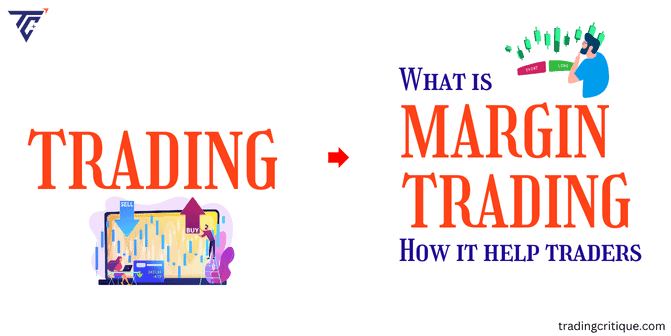Margin trading is taking out a loan from a brokerage company to make transactions. When trade on margin, investors make a cash deposit that acts as security for the loan, and they subsequently continue to pay interest on the money they borrow.
Before enter the margin trading process you should knowing the meaning of margin.What is the meaning of margin? Margin refers to the funds borrowed by a broker for the purchase of an investment, which is the difference between the investment’s whole value and the loan amount.
What is margin trading?
Margin trading is when the investor borrows cash from a broker to buy securities, sell securities short, or use derivatives, such as futures and some types of options.
Through margin trading, investors can buy more stocks than they can afford. Purchasing equities at the marginal price as opposed to their market price allows investors to make large gains. To purchase the stocks, your stockbroker will give you a credit, and just like any other loan, this one will come with paying interest.
For example, you may purchase up to $10,000 worth of marginable stock if you have $5,000 in cash in a brokerage account that has been approved for margin: Using the marginable stock you bought as collateral, your brokerage company would lend you an additional $5,000 after you used your funds to cover the first $5,000.
How does margin trading work?
The Federal Reserve, the Financial Industry Regulatory Authority (FINRA) all have strict rules on margin trading. Although brokers may have their regulations, all margin trading works follows some basic regulations.
The following ideas and terms should be understood by investors purchasing assets on margin.
| Margin trading working factors | Margin trading works |
|---|---|
| Create lower minimum margin | This is the smallest amount that an investor must deposit or invest to create a margin account with a brokerage. Its work is based on a minimum deposit of $2000 or 100% of the purchase price of margin securities whichever is lower. |
| Require initial margin | When buying securities margin is a percentage of the initial purchase price with your own money. Margin trading sells up to 50% of the stock’s original purchase price under Federal Reserve Regulation T, but some companies want higher margin requirement. |
| Interest consideration | It is the amount of margin loan provided by the broker to the investor which is paid to the broker regularly. It is a periodic payment and it is considered an annual percentage. |
| Determine maintenance margin | When investors purchase assets on margin, the broker will require them to maintain a minimum level of equity. It works under FINRA considering the minimum 25% requirement. However, the firm may require up to 40%. |
What is a margin position?
“Margin Position” refers to a contract that is established, maintained, and relies on a collateral deposit that always meets the required margin. You may find out your margin position and whether you are getting close to your minimal total equity balance from the summary of your financial position.
The quantity of collateral that you must provide as security to engage in a margin position is known as the initial margin while margin refers to the amount of money you need to put up as collateral for each trade.
What is a margin balance?
Margin balance referred to as when an investor borrows money from a brokerage firm to make trades, the amount held in their margin account. Often establishing a margin account, an investor must pay the initial investment.
The Financial Industry Regulatory Authority (FINRA) sets a minimum margin requirement of $2,000; however, some brokerages may have higher minimums. It can help traders to increase their expected returns if used carefully.
What is margin account?
A margin account is an investor’s avenue for borrowing money to buy financial items through a form of brokerage account. A monthly interest rate is due from investors on the amount borrowed from the brokerage. If you want to trade stocks with a margin account, you might also call it a broker’s loan account.
How does a margin account work?
An investor needs a margin account to purchase and sell securities at margin prices. Brokers lend the margin amount to the investor. Interest is also charged on this account. Also, a maintenance margin is required, meaning a minimum fixed dollar amount is required to trade on the margin.
The amount borrowed is deducted from the account’s total equity, which includes cash and any securities’ worth, to determine the minimum margin amount. An investor receives a margin call from the brokerage firm if the equity in a margin account drops below the maintenance margin level.
A brokerage firm reserves the right to ask a client to increase the amount of capital held in a margin account. If they have a negative account balance, the brokerage firm has the right to sell the securities.
What is margin interest?
Margin interest is the amount of buying on margin assets and repaying the loan amount plus interest. It works like when buying any other property. It varies from one broker to another depending upon the brokerage firm.
How does margin interest work?
The base rate and the amount of debt determine the different margin interest rates. It works simply the following: Daily Interest Charge = Interest Rate x Margin Debit / 360. The total interest amount will be posted to your account at the end of each month, even if it is computed daily.
Calculation of margin interest
Daily Interest Charge = Interest Rate x Margin Debit / 360.
where:
Interest Rate = Rate per year
Margin debt = Amount borrowed
360 = Number of days borrowing
For Example: you borrow the amount of $ 30000 to buy stocks on margin when the rate of interest is 6%.
Interest rate (0.06) x Margin Debit (30000) /360 = Daily Interest Charge ($5).
Rather than the expected 365 days, the brokerage field usually uses 360 days.
How to trade on margin?
There are some key factors that influence on margin trading. Let us look at them briefly here:
Create a trading account
The first step is to open a trading account. For that, you must fill out a form and then your details will be verified. Now you can deposit money into your account and start trading. If you have any doubts or lack of experience, open a demo account, and offer $2000 in virtual money.
Know how margin works
Knowing that the margin works will give us clarity that we can travel on it. You can also know about the risks involved. This prevents losing more money.
Choose your margin trading approach
You will trade on margin when you trade with us using leveraged derivatives, sometimes referred to as CFDs. You may monitor the movement of the underlying markets’ prices with these financial instruments.
Locate an opportunity
There are over 17,000 popular markets where you can trade on margin. Select your desired one from these markets. These are stocks, commodities, forex, and indices.
Make your initial trade
You can set your position size after completing the previous steps. Once you place your trade and keep an eye on its price changes, do not forget to take the required precautions to limit your risk.
Conclusion
Margin is the amount of borrowing money form the broker for investment. Investor access margin trading when they want to choosing it does not have enough money to invest and wants to trade more than the amount of money, they have at some time this will happen.
In the world of finance, margin trading is a powerful instrument that magnifies profits. Although it offers chances for increased earnings, it has risks of its own, such as the possibility of amplified losses, interest expenses, and regulatory limitations.
Pro Tips
As you explore the basics of margin trading, it’s crucial to deepen your understanding of CFD trading and select the assets you’re interested in. Choose from a wide array of options such as forex, stocks, indices, and commodities available for margin trading. Partnering with our regulated forex trading broker will further enhance your knowledge of these financial instruments and guide you in making well-informed trading decisions. This comprehensive approach combines practical experience with expert advice, paving the way for a more successful trading journey.
FAQ – Frequently Asked Question
1. What is margin in investing?
Borrowing money from a brokerage business is known as margin investing. Traders use this to increase their buying power and then repay the loan on the date of their selection. However, in real life, big risks and sudden losses may add up fast. This means that new investors need to utilize it carefully.
2. Is margin trading legal?
Yes, Firms operating investment funds that legally engage in margin trading are likewise required to register. Customers’ personal and financial information should be routinely verified, and they should be provided with clear information about risks associated with leverage trading.
3. How much amount is required to a margin account?
FINRA, the government-authorized regulator of brokerage structures, mandates that you deposit at least $2,000 or 100% of the security’s purchase price into your account if you want to buy it with leverage.
4. What should be carefully handled in margin trading?
Margin trading may increase earnings and create trading possibilities for individuals who are aware of risks and have a lot of experience in the market. Kindly make note of all the cautions involving margin loans and waiting to enter until you have an idea of what you are getting into.
5. What is meant by margin deposit?
The amount you will need to place your trade is known as a margin deposit. It is determined by the margin rate, which is given as a percentage.
6. What is a margin call?
Your brokerage company may require that you increase the amount of equity in your account, which is known as a margin call. This can be performed by making cash deposits into your account, trading away current assets to raise cash, or transferring cash or marginable securities.



![Commercial Banking What is it How does it work [Things to Know]](https://tradingcritique.com/wp-content/uploads/2024/09/Commercial-Banking-What-is-it-How-does-it-work-Things-to-Know-150x150.png)



